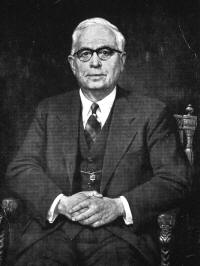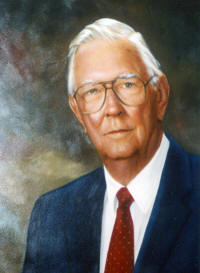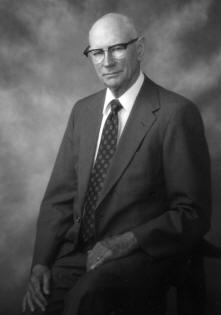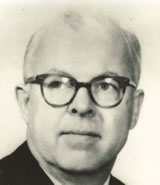
William H. Townsend
William H. Townsend
When Lexington attorney William H. Townsend appeared before the Chicago Civil War Round Table in October 1952, he delivered a classic address in his own inimitable style. Towsend’s eloquent and witty presentation on the “Lion of White Hall,” old Cassius Marcellus Clay, gained national attention, first as a recording, and then as a book. And the talk that autumn night stimulated interest in the creation of a Kentucky round table.
After some informal discussion, a group met—appropriately enough in Townsend’s office—on 28 October 1953. The dozen central Kentuckians included President Herman Lee Donovan of the University of Kentucky, A.D. Kirwan, Holman Hamilton, Hambleton Tapp, J. Winston Coleman Jr., and the Rev. Robert Stuart Sanders, all then of Lexington, and Marion Rider, Willard Rouse Jillson, George L. Fowler, and George M. Catlett, all of Frankfort. Townsend and State Commissioner of Aeronautics John A. Diskin completed the group. Out of this meeting, the Kentucky Civil War Round Table originated.
Two weeks later, on 18 November, 1953, the first of many dinner meetings was held and the KCWRT’s first leaders were selected. These included attorney, historian, author, raconteur, and Lincoln expert William H. Townsend, president; co-founder, lawyer, and public official John A. Diskin, vice president; Hambleton Tapp, teacher, author, and later State Historian, secretary; and banker Edward S. Dabney, treasurer. Members chose an executive committee consisting of historians Thomas D. Clark and J. Winston Coleman Jr.; educators Herman Lee Donovan, President Frank A. Rose of Transylvania University, and President Philip C. Davidson of the University of Louisville; Louisville Mayor Charles P. Farnsley; geologist-historian Willard R. Jillson, and railroad president George L. Fowler. The biographer of “Old Zack” Taylor, Dr. Holman Hamilton, was selected as program chairman. Under the guidance of these officers, the Round Table began what would be a period of steady and often spectacular growth.
By May 1958, the membership desired to modify the provision limiting the president to four consecutive terms, for if that restriction remained, popular Townsend would have to step down. Members removed the restrictions and re-elected Townsend by acclamation. They would continue to renew this decision every year until his death. The tradition of election by acclamation has continued over the years.
Holman Hamilton
Holman Hamilton
For many years he served as Chairman of the Editorial Board of the University Press of Kentucky. He served as Chairman of the Publications Committee of the Lexington-Fayette County Historical Commission, was President of the Kentucky Civil War Round Table, and was a member of the Review Board of the Kentucky Heritage Commission. He was a life member of the UK National Alumni Association and a University Fellow.
But on 25 July 1964, William H. Townsend died. At the next Round Table meeting, members unanimously elected Holman Hamilton of the University of Kentucky president, For over a decade “Bill” Townsend had been the spirit of the Round Table, and the new president would continue those traditions for the eleven years he would serve. In 1965, for example, the Civil War Centennial Commission gave the organization a Centennial Medallion, “For its extraordinary contributions in further the study of the Civil War.” While Round Tables elsewhere declined with the ending of the Civil War Centennial, the Kentucky Civil War Roundtable reversed this pattern. Steady growth in both interest and membership continued to be a trait, and the organization had to move in 1967 to the Springs Inn. Excellent speakers and enjoyable meetings made membership in the Kentucky Civil War Round Table increasingly valued and enjoyed. So outstanding was the Kentucky example that the August 1972 issue of Civil War Times Illustrated published an article explaining the KCWRT’s success. President Hamilton stressed that the five-meeting format made each gathering “an event rather than an incident.” First-rate speakers, often in great demand nationally, could thus be booked and an adequate honorarium offered. In selecting speakers, topics and variety were stressed, the article continued, and “dull, drab and dry” liabilities were avoided. The speakers chosen “look more at their audiences than at the paper before them, they see their audiences individually as well as en masse,” reacting to the reception with sensitivity and skill. In turn, the audience is responsive and knowledgeable. Together these combine so that once here, the good speakers want to return. President Hamilton stressed other factors in success: decently priced meals, varied backgrounds of the members, an excellent newsletter, low dues, and organizational integrity. All in all then, the KCWRT “Stresses historical facts, to be sure, but emphasizes friendship even more. Mutual respect and liking are pervasive.”
In the Civil War Times Illustrated article, Hamilton also attributed the organization’s success, in small part, to low dues. As late as 1993, they remained at $15 per year; the current dues of $25 remained at that level for over a decade. All that–the dues, the camaraderie, the speakers, and other things–brought more and more people to become members. Two years after the Round Table organized, it had two hundred members; in 1968, it neared the four hundred mark. In the next decade membership edged past five hundred and currently, the Round Table has over four hundred and fifty members, apparently making it the largest in the nation.

Buddy Thompson
Buddy Thompson
Another reason for success, which President Hamilton had modestly not mentioned, concerned leadership, from the president and vice president on to the secretary, treasurer, and newsletter editor. A series of excellent treasurers have, for example, kept the organization solvent and the bills paid. Edward S. Dabney served in that capacity for the first thirteen years of the organization, to be followed by E.I. “Buddy” Thompson’s nine-year reign. After Buddy became president, Robert H. Hillenmeyer performed his financial magic until he stepped down in 1989. At that time, trust attorney Jack R. Cunningham became treasurer. Over the last quarter-century in particular, strong growth in the budget has allowed the organization to continue to bring in top-notch speakers, begin a new award, and give contributions to needy causes. The Round Table has, for instance, given thousand dollar grants to the Southern History Fellowship at the University of Kentucky, to honor Dr. Roland, as well as ones to the Kentucky Military History Museum, the Kentucky Historical Society (for Civil War flag restoration), and the Perryville Battlefield Association. And all that occurred with no dues increase for over a decade. In short, when you combine good prices and moderate dues with everything else offered, the Kentucky Civil War Round Table remains an excellent bargain.
Currently, the newsletter provides meeting news and information. Prepared by Burton Milward for fifteen years until 1973, it was expertly done, and that tradition was continued and strengthened by another fifteen years of like editing by Paul Crowdus. After Crowdus stepped down as newsletter editor in 1988, then-Secretary Klotter functioned as interim editor for a year and Kevin Simon did the same for another year. Nicky Hughes took on the duties of editor in 1990 and served in that capacity for over a decade, all the time continuing the high standards of those who had gone before him. Since the year of the official beginning of the twenty-first century, Harold Tallant, a professor of history at Georgetown College, has done an excellent job of getting the newsletter out in a timely manner, with interesting stories and important news. In short, he continues the Round Table tradition of having excellent newsletter editors.
Once the announcements have been received, members send in postcards indicating whether they can attend or not. Counting those and arranging for the meal itself are some of the many duties of the organization’s secretary. Secretary Hambleton Tapp, who served over three decades in that position gave heart, soul, and immeasurable hours of work to the KCWRT. In 1984, Secretary Tapp retired and members named Jim Klotter to become the second person to hold that post, and he did so for a decade. When Secretary Klotter took over as president of the Round Table in 1994, F. Kevin Simon, a teacher at Sayre School, became the organization’s third holder of that secretary position. He built on past work, and took the organization to new levels with his wise counsel, sound advice, and good cheer. Tragically, his life was cut short at an early age when he died unexpectedly in the spring of 2002. At the next meeting, members adopted a series of resolutions honoring him, the last of which reads: “Let it be further resolved, that while the Round Table honors Kevin Simon’s rich legacies as historian, teacher, and human being, we also celebrate his life through our continuing memories.”
At that same meeting, members chose a new secretary, who came to office amid those difficult circumstances. William J. Marshall of the University of Kentucky Library quickly showed that he deserved the responsibilities given him by the members and has done an excellent job in his new post. His work, the efforts of the newsletter editor, the support of the three vice presidents– currently Charles G. “Chuck” Williamson Jr., Edward “Mac” Coffman, and Herbert D. Sledd–all did so much to make meetings successful.
Leading all those efforts have been a series of strong presidents, starting with Bill Townsend and then Holman Hamilton. Dr. Hamilton’s eleven-year term as president had been highly successful, as the Civil War Times Illustrated article revealed. In 1975 the committee nominated as his successor, auctioneer and realtor E.I. “Buddy” Thompson. Only five years later, on 7 June 1980, just months after his presidency of the Southern Historical Association, Holman Hamilton died. Round Tablers knew what the memorial service speaker meant when he concluded that “We all shall carry something of Holman Hamilton with us throughout our lives.”

Charles P. Roland
Charles P. Roland
In the May 1975 meeting, members selected then-Treasurer Buddy Thompson as only the third head of the Round Table. The humor, oratorical abilities, and leadership qualities of President Thompson amply upheld the traditions of his predecessors. Programs continued to be equally successful with Dr. Charles P. Roland in the role of Program Chairman. Members enjoyed a November 1975 tour to the Kentucky Gettysburg Marker dedication and likewise a September 1976 visit to Chickamauga and Missionary Ridge battlegrounds. Tour Director “Chuck” Williamson was a highly important factor in making these outings both enjoyable and educational for members and their wives. When President Thompson presided over the thirtieth anniversary of the organization in 1983, he thus had much to be proud of during his time in office. That gathering included a free bar, a complimentary booklet on the Round Table history, and more of Buddy’s famous stories. A year after that, the president asked that others take up his tasks and members made the change in 1984.
New president Charles P. Roland, then a professor of history at the University of Kentucky, would serve for a decade. During that time, membership and treasury funds both grew, and the organization gained formal 501 (c) (3) nonprofit status. It also inaugurated the Townsend- Hamilton Award, to be given only on special occasions to a person making a significant national contribution to Civil War history. Four people have been named as recipients. In order, they are James I. “Bud” Robertson Jr., Charles P. Roland, William C. “Jack” Davis, and Gary Gallagher.
Change occurs in any organization and that held true for the KCWRT as well. After a decade as a popular president, Dr. Roland requested relief from those duties and, in 1994, members chose as the Round Table’s fifth president, James C. Klotter, then the Executive Director of the Kentucky Historical Society and currently the State Historian of Kentucky and Professor of History at Georgetown College. More changes took place under President Klotter as the group heard its first woman speaker and welcomed its first woman member. Still, traditional approaches dominated as a speakers’ committee continued to bring in fine keynoters, as jokes of varying quality (frequently bad) continued to be offered, and as good fellowship continued to be enjoyed. When the Rev. Harold Dorsey got up to offer a benediction, members know that they have been part of an evening with good friends, a time when they have laughed and learned, a moment filled with pleasant memories from a unique organization—the Kentucky Civil War Round Table.

